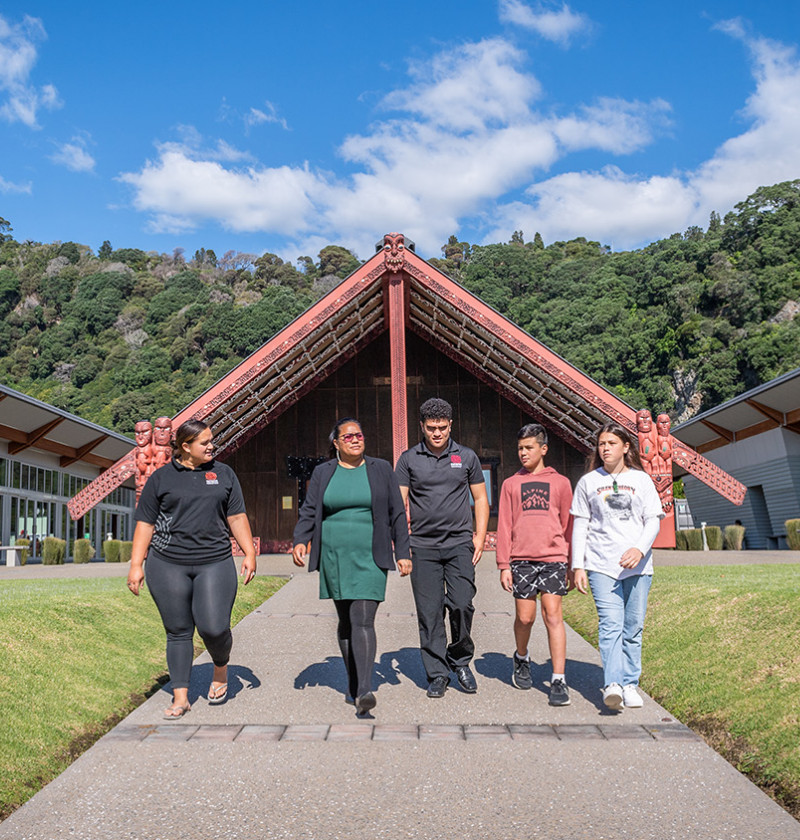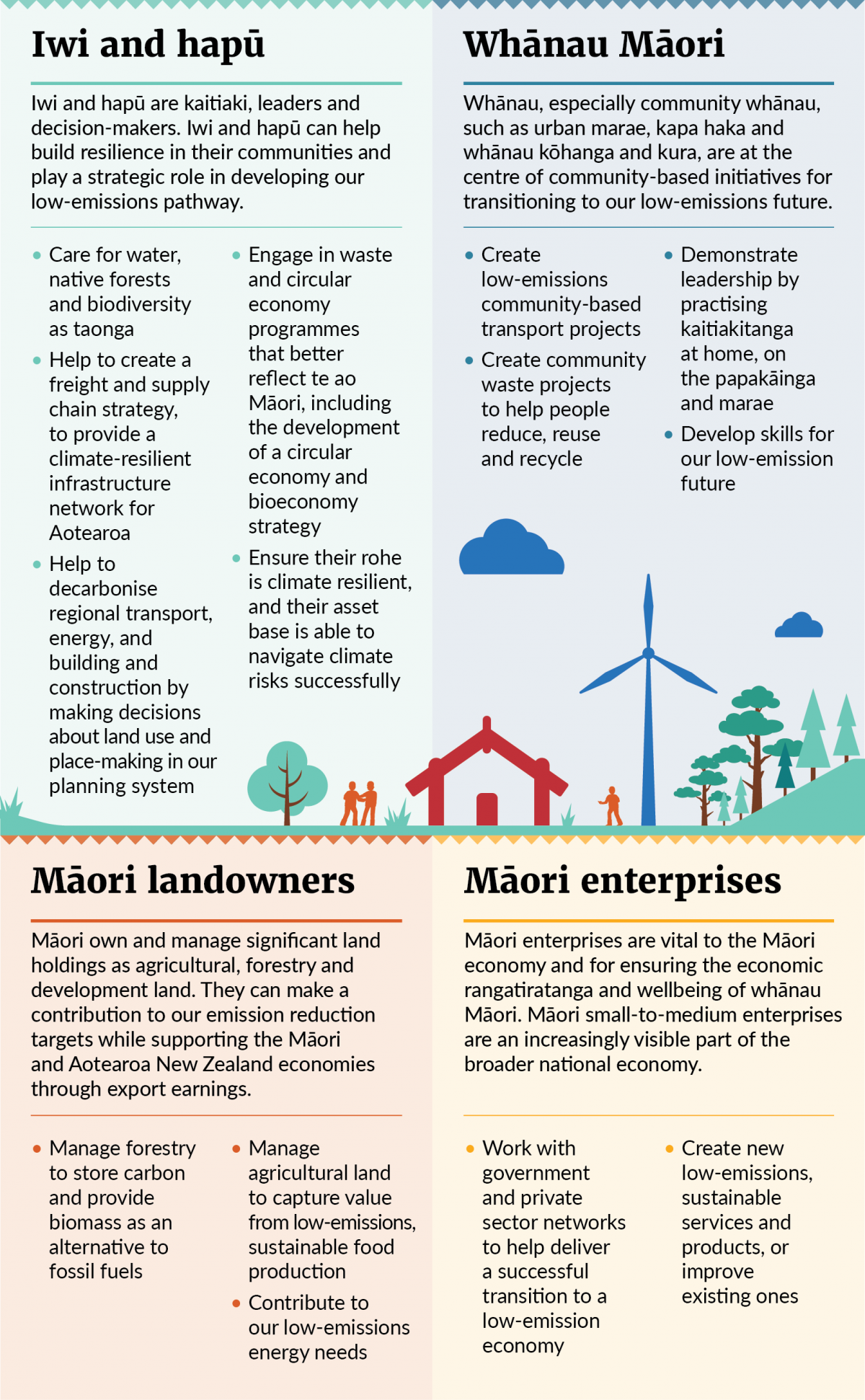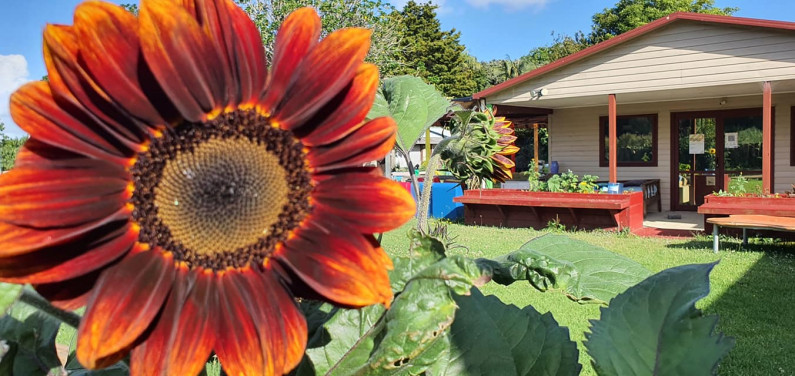Chapter 2 Empowering Māori

Download a PDF version of this chapter [PDF, 823 KB]
All Ministers are responsible for upholding Te Tiriti o Waitangi.
Climate change, and our response to it, has the potential to affect all aspects of Māori life. Tangata whenua are especially vulnerable to the effects of climate change and there are particular risks and opportunities for the Māori economy in the transition.
Māori are kaitiaki of their whenua, leaders in their communities, decision makers about resources and infrastructure, landowners and business owners. Māori will help lead the transition in each of these roles. Mātauranga Māori will help us learn and better inform our decision making.
We need to ensure an equitable transition for Māori, led by Māori, to uphold their rights and interests under Te Tiriti o Waitangi. That will require building Crown–Māori relationships and capability to work together as equal partners on our climate response.
Māori and He Pou a Rangi – Climate Change Commission (the Commission) have signalled that it is important to use kaitiakitanga as a guiding principle for our transition. The Government has also heard that our transition will be more successful, and more equitable for Māori, if it:
Prioritising this guidance will help deliver a transition that embodies Te Tiriti principles of partnership, participation, protection and equity for Māori.
To achieve this, the Government is establishing a platform for Māori climate action. The platform for Māori climate action will be a space to build relationships and capacity on both sides of the Crown–Māori relationship, to provide more equal partnership and improve knowledge and data to help Māori plan for transitional and climate change impacts.
The platform will build on the three focus areas of: partnership and representation, strategy and alignment, and community activation. It will support the expertise and leadership of Māori, empower Māori and elevate te ao Māori in the context of the transition. It will serve as one vehicle to support an equitable transition for Māori, led by Māori.
Māori are already demonstrating leadership and expertise that will help our transition to a low-emissions and climate-resilient society. We can learn from that expertise.
At a governance level, Māori are challenging ‘business as usual’ thinking and seeking ways to reduce emissions while growing productivity and capital. Navigating the need for high productivity and associated social and environmental impacts is familiar to Māori, who are well practised at balancing kaitiakitanga obligations with development aspirations and the competing priorities of their people.
Māori play an important role as kaitiaki of their whenua, leaders in their communities, decision-makers about resources and infrastructure, landowners changing their practices, business owners supporting a low-emissions economy and as communities helping to change behaviour.
Māori will play a key role in partnering with the Crown to develop an equitable transition strategy, a circular economy and bioeconomy strategy and an energy strategy. For more information, please see the chapters on these topics.

Iwi and hapū
Iwi and hapū are kaitiaki, leaders and decision-makers. Iwi and hapū can help build resilience in their communities and play a strategic role in developing our low-emissions pathway.
Whānau Māori
Whānau, especially community whānau, such as urban marae, kapa haka and whānau kōhanga and kura, are at the centre of community-based initiatives for transitioning to our low-emissions future.
Māori landowners
Māori own and manage significant land holdings as agricultural, forestry and development land. They can make a contribution to our emission reduction targets while supporting the Māori and Aotearoa New Zealand economies through export earnings.
Māori enterprises
Māori enterprises are vital to the Māori economy and for ensuring the economic rangatiratanga and wellbeing of whānau Māori. Māori small-to-medium enterprises are an increasingly visible part of the broader national economy.

Iwi and hapū
Iwi and hapū are kaitiaki, leaders and decision-makers. Iwi and hapū can help build resilience in their communities and play a strategic role in developing our low-emissions pathway.
Whānau Māori
Whānau, especially community whānau, such as urban marae, kapa haka and whānau kōhanga and kura, are at the centre of community-based initiatives for transitioning to our low-emissions future.
Māori landowners
Māori own and manage significant land holdings as agricultural, forestry and development land. They can make a contribution to our emission reduction targets while supporting the Māori and Aotearoa New Zealand economies through export earnings.
Māori enterprises
Māori enterprises are vital to the Māori economy and for ensuring the economic rangatiratanga and wellbeing of whānau Māori. Māori small-to-medium enterprises are an increasingly visible part of the broader national economy.

Papatūānuku Kōkiri Marae in Māngere, Tāmaki Makaurau (Auckland) is a hub of community education, tikanga and practice that embodies the vision of Oranga Whenua Oranga Tangata, which the marae has had for the past 30 years.
Supported through funding from local and central government, Papatūānuku Kōkiri Marae are champions of waste minimisation and Māori food sovereignty through their commitment to Hua Parakore – a framework for growing kai that connects the kaupapa of whakapapa, wairua, mana, māramatanga, mauri and te ao tūroa.
The marae māra is replenished by compost created from the kitchen’s scraps, eliminating use of synthetic fertiliser, organic material going to landfill, and the associated emissions.
Another initiative – Kai Ika – ensures no part of a fish is wasted – by rescuing what is left after filleting by commercial and recreational fishers. The offal is used on the māra, while the frames and heads are redistributed to whānau throughout the city.
An important element of Māori food sovereignty is self-sufficiency, reducing the need for fossil-fuelled supply chains by producing and distributing kai locally. Papatūānuku Kōkiri Marae grows food for their marae kitchen, their community, farmers markets and restaurants, and teaches others how to do the same, ensuring that the whenua of Tāmaki Makaurau sustains the people of Tāmaki Makaurau.
Climate change demonstrates the profound interconnectedness of our world. The principle of interconnectedness is at the heart of te ao Māori, or the Māori worldview.
Te ao Māori is a holistic world where all life is connected. The spiritual realm is complemented by the physical realm, and both are interdependent. In this sense, a whakapapa (genealogy) relationship links the physical and spiritual worlds. Pūrākau (stories) express this connection and are powerful frameworks for relating to the natural environment as living tūpuna (ancestors), to be revered and cared for. This whakapapa relationship also links the wellbeing of Māori people to the wellbeing of the natural environment.
Te ao Māori values can be represented in many forms that may be specific to a group, for example, in taonga species, waterways or ancestral sites of significance. Values can also be practised in te reo and other social systems that shape our relationships with each other and the environment. Tikanga Māori supports this by providing the guidelines and procedures by which we conduct ourselves and make decisions. Values or principles that protect and uphold te ao Māori, such as kaitiakitanga (guardianship), manaakitanga (hospitality) and whanaungatanga (family connection), are common to all iwi, hapū and marae, however, they may be practised in varying ways.
When Māori practise kaitiakitanga, manaakitanga and whanaungatanga, they can use mātauranga Māori to observe and interpret the health of the connections between living systems, and make changes to their practices where necessary to restore balance. Signs of unease in Aotearoa New Zealand’s climate, taonga and in people indicate imbalance in te ao Māori, and require us to correct this by modifying our goals, practices and behaviour.
Mātauranga Māori is grounded in te ao Māori. It is defined here as Māori knowledge, Māori methods of knowledge creation and Māori ways of knowing and engaging with the world. It encapsulates both traditional and oral knowledge as well as knowledge produced by Māori in response to new kinds of problems, experiences and technology.* Like other knowledge systems, mātauranga Māori is a systematically organised body of wisdom with its own traditions, philosophical base, methodologies and criteria. Mātauranga Māori is a taonga to Māori and its use must be led by Māori.
Our transition to a climate-resilient society will depend on a diverse range of approaches, beyond Western knowledge systems.
The United Nations recognises that indigenous peoples’ contribution to climate change mitigation and adaptation is key to the international climate change response.** Indigenous knowledge can guide sustainable development and complements other research and policy by placing them in local contexts. Traditional knowledge passed down through generations also helps scientists to better understand historical trends of ecosystem health, biodiversity and climate adaptation.***
Mātauranga Māori will play a role in Aotearoa New Zealand’s climate response by:
Recognising the importance of mātauranga Māori in the climate response is one way the Government will uphold Te Tiriti. This will involve protecting the relationship of Māori with taonga and providing support and access to the same resources, tools, institutions and developments as other knowledge systems.
Te Tiriti, mātauranga Māori, and Māori aspirations will be embedded and supported in our research, science and innovation system through the Ministry of Business, Innovation and Employment’s Vision Mātauranga policy. The work of Te Puni Kōkiri on Te Pae Tawhiti [Te Puni Kōkiri website] – the whole-of-government response to Wai 262 – will help to establish an overarching framework to safeguard and safely innovate mātauranga Māori and taonga (see the chapter about research, science, innovation and technology).
* A Guide to Vision Mātauranga: Lessons from Māori Voices in the New Zealand Science Sector [PDF, 3.1 MB]
** UN/DESA Policy Brief #101: Challenges and Opportunities for Indigenous Peoples’ Sustainability [Department of Economic and Social Affairs, United Nations website]
The United Nations recognises that the impact of climate change tends to affect indigenous communities before others, due to their dependence on, and relationship with, the natural environment. Climate change also compounds the economic, political and social vulnerability of indigenous peoples in many countries.*
In Aotearoa, higher land and ocean temperatures, sea-level rise, variations to seasonal patterns and extreme weather events are already affecting tangata whenua livelihoods, homes and taonga species. Climate change will affect the availability of mahinga kai (food-gathering areas) and food production on Māori land. Some coastal areas will become unliveable. Impacts on the Māori and wider economy could limit whānau access to food, electricity, housing and health services, which will compound existing inequalities of wealth and wellbeing. Links to tūrangawaewae, mahinga kai and other sites of significance may be broken, affecting cultural and physical wellbeing.**
Reducing emissions will help reduce the impacts of climate change on Māori and therefore is fundamental to achieving an equitable transition for Māori. However, Māori are also especially vulnerable to the costs of meeting emissions reductions, particularly because they are disproportionately represented amongst low-income earners.
Impacts may be amplified for tāngata whaikaha Māori (Māori disabled people and their whānau) – the equitable transition strategy will need to consider this. Māori enterprises, particularly small- and medium-sized enterprises, are concentrated in the emissions-intensive industries of agriculture, construction, transport, postal and warehousing, and manufacturing. They may face regulatory change as well as higher costs related to increasing emissions prices (see the chapter about an equitable transition).
The transition will impact Māori, but it will also present new opportunities. Māori need to build capacity and capability to prepare for climate change impacts and identify opportunities in the transition for Māori businesses and investments. An equitable transition strategy will be developed by Māori, in partnership with the Crown, to manage the impacts, build capability and seize the opportunities of the transition.
* Climate change and indigenous peoples backgrounder [PDF, 1.3 MB]
** National Climate Change Risk Assessment for Aotearoa New Zealand: Main report – Arotakenga Tūraru mō te Huringa Āhuarangi o Āotearoa: Pūrongo whakatōpū [PDF, 5.1 MB];
He huringa āhuarangi, he huringa ao: A changing climate, a changing world. Report prepared for Ngā Pae o te Māramatanga [PDF, 2.4 MB]
The Commission recommended that the Government take action in partnership with Māori to build enduring and authentic relationships with Māori, embed the principles of Te Tiriti in emissions reduction plans and advance a Māori-led approach to an equitable transition for Māori and the Māori economy.
Māori have advised that they:
The platform for Māori climate action is the key mechanism through which the Government is looking to build a climate response partnership with Māori and address these recommendations. The platform would build on three focus areas to:
Actions that support an equitable transition for Māori are noted here, and are described in more detail in each of the relevant chapters. Actions across the emissions reduction plan might sometimes interact with Te Tiriti settlement commitments. The Government will engage with the relevant iwi/hapū if this happens, and ensure those commitments are upheld.
To build Te Tiriti partnership and greater recognition of Māori rights and interests, including Treaty settlement commitments, into the climate response, the Government will:
To ensure diverse Māori input into climate policy and action, the Government will:
To elevate te ao Māori within the climate response, the Government is developing proposals to:
The Government will also investigate creating community-facing climate planning and education tools to support:
To bolster kaupapa Māori, tangata Māori solutions and their impact, the Government will provide a dedicated fund to:
The emissions reduction plan integrates actions that contribute to an equitable transition for Māori across many chapters. These include actions to:

Chapter 2 Empowering Māori
May 2022
© Ministry for the Environment